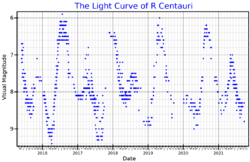Astronomy:R Centauri
| Observation data Equinox J2000.0]] (ICRS) | |
|---|---|
| Constellation | Centaurus |
| Right ascension | 14h 16m 34.319s[2] |
| Declination | −59° 54′ 49.29″[2] |
| Apparent magnitude (V) | 5.2 - 11.5[3] |
| Characteristics | |
| Spectral type | M5IIe[4] (M4e-M9.5[3]) |
| U−B color index | +1.24[5] |
| B−V color index | +2.04[5] |
| Variable type | Mira[3] |
| Astrometry | |
| Radial velocity (Rv) | −19.8[6] km/s |
| Proper motion (μ) | RA: −9.077[2] mas/yr Dec.: −6.692[2] mas/yr |
| Parallax (π) | 1.1082 ± 0.2413[2] mas |
| Distance | approx. 2,900 ly (approx. 900 pc) |
| Absolute magnitude (MV) | −1.49 (at maximum)[7] |
| Details | |
| Radius | 615[8] R☉ |
| Luminosity | 47,000[4] L☉ |
| Surface gravity (log g) | −0.733[8] cgs |
| Temperature | 3,450[4] K |
| Other designations | |
R Centauri, HR 5326, HD 124601, CP−59°5476, HIP 69754, SAO 241580, GC 19234, CCDM J14166-5955 | |
| Database references | |
| SIMBAD | data |
R Centauri (R Cen) is a Mira variable star in the constellation Centaurus.
The distance to R Centauri as indicated by its Gaia Data Release 3 parallax is about 2,900 light years, but that is considered to be potentially unreliable.[2] The Gaia Data Release 2 parallax was negative and relatively meaningless.[9] The older Hipparcos parallax suggested a distance of about 1,300 light years, but with a wide margin of error.[10] Estimates based on an assumed brightness for the star, adjusted for extinction, give distances as low as 750 light years.[11]
The effective temperature of R Centauri's photosphere has been calculated by different methods to be 2,403 K[8] or 3,450 K.[4] Its luminosity is even more uncertain, depending on assumptions about the distance. At a distance of 384 pc, the bolometric luminosity would be 11,342 L☉,[8] while assuming a larger distance of 640 pc the luminosity would be over 47,000 L☉.[4] In either case, it is a very large star, over 600 R☉.[8]
R Centauri is a Mira variable and its brightness varies from magnitude +5.2 to +11.5 with a period of about 500 days. It used to have an unusual double-peaked light curve, but by 2001 this had reverted to an almost normal single-peaked curve. Prior to 1950 the period was about 550 days, but since then has decreased to about 500 days. A 2016 analysis of ASAS data derived a period of 498.84 days.[12]
It is thought that the unusual behaviour of R Centauri is caused by a flash in the helium shell around its core, which occurs periodically in asymptotic giant branch (AGB) stars as the mass of the helium shell increases with helium from the outer hydrogen shell.[13] It is also an H2O maser source.[14]
References
- ↑ "Download Data". AAVSO. https://www.aavso.org/data-download.
- ↑ 2.0 2.1 2.2 2.3 2.4 2.5 Vallenari, A. et al. (2022). "Gaia Data Release 3. Summary of the content and survey properties". Astronomy & Astrophysics. doi:10.1051/0004-6361/202243940 Gaia DR3 record for this source at VizieR.
- ↑ 3.0 3.1 3.2 Samus, N. N. et al. (2009). "VizieR Online Data Catalog: General Catalogue of Variable Stars (Samus+ 2007-2013)". VizieR On-line Data Catalog: B/GCVS. Originally Published in: 2009yCat....102025S 1. Bibcode: 2009yCat....102025S.
- ↑ 4.0 4.1 4.2 4.3 4.4 Verhoelst, T; Van Der Zypen, N; Hony, S; Decin, L; Cami, J; Eriksson, K (2009). "The dust condensation sequence in red supergiant stars". Astronomy & Astrophysics 498 (1): 127–138. doi:10.1051/0004-6361/20079063. Bibcode: 2009A&A...498..127V.
- ↑ 5.0 5.1 Hoffleit, Dorrit; Jaschek, Carlos (1991). "The Bright star catalogue". New Haven. Bibcode: 1991bsc..book.....H.
- ↑ Wilson, R.E (1953). "General Catalogue of Stellar Radial Velocities". Carnegie Institute Washington D.C. Publication (Washington: Carnegie Institution of Washington). Bibcode: 1953GCRV..C......0W.
- ↑ Celis s, L. (1986). "Spectral and luminosity variation of long-period red variable stars". The Astronomical Journal 91: 405. doi:10.1086/114019. Bibcode: 1986AJ.....91..405C.
- ↑ 8.0 8.1 8.2 8.3 8.4 McDonald, I.; Zijlstra, A. A.; Watson, R. A. (2017). "Fundamental parameters and infrared excesses of Tycho-Gaia stars". Monthly Notices of the Royal Astronomical Society 471: 770–791. doi:10.1093/mnras/stx1433. Bibcode: 2017MNRAS.471..770M.
- ↑ Brown, A. G. A. (August 2018). "Gaia Data Release 2: Summary of the contents and survey properties". Astronomy & Astrophysics 616: A1. doi:10.1051/0004-6361/201833051. Bibcode: 2018A&A...616A...1G. Gaia DR2 record for this source at VizieR.
- ↑ van Leeuwen, F. (2007). "Validation of the new Hipparcos reduction". Astronomy and Astrophysics 474 (2): 653–664. doi:10.1051/0004-6361:20078357. Bibcode: 2007A&A...474..653V. http://www.aanda.org/index.php?option=com_article&access=bibcode&Itemid=129&bibcode=2007A%2526A...474..653VFUL. Vizier catalog entry
- ↑ Celis, L. (1995). "Luminosity Attenuation and Distances of Red Giant Stars". The Astrophysical Journal Supplement Series 98: 701. doi:10.1086/192175. Bibcode: 1995ApJS...98..701C.
- ↑ Vogt, N; Contreras-Quijada, A; Fuentes-Morales, I; Vogt-Geisse, S; Arcos, C; Abarca, C; Agurto-Gangas, C; Caviedes, M et al. (2016). "Determination of Pulsation Periods and Other Parameters of 2875 Stars Classified As Mira in the All Sky Automated Survey (Asas)". The Astrophysical Journal Supplement Series 227 (1): 6. doi:10.3847/0067-0049/227/1/6. Bibcode: 2016ApJS..227....6V.
- ↑ Hawkins, G; Mattei, J. A; Foster, G (2001). "R Centauri: An Unusual Mira Variable in a He‐Shell Flash". Publications of the Astronomical Society of the Pacific 113 (782): 501. doi:10.1086/319542. Bibcode: 2001PASP..113..501H.
- ↑ Lepine, J.R.D.; Paes de Barros, M.H. (1977). "Characteristics of the H2O emission from Mira variables". Astronomy and Astrophysics 56: 219–226. Bibcode: 1977A&A....56..219L.
 |


